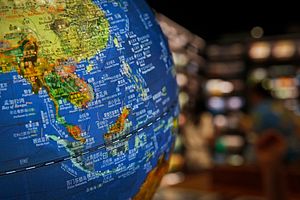On July 3, Chinese survey ship Haiyang Dizhi 8 (HD8), escorted by the China Coast Guard and maritime militia, began surveying a large swath of seabed northeast of Vanguard Bank. The area sat within Vietnam’s exclusive economic zone (EEZ) and continental shelf. Hanoi responded by sending its own coastguard and fisheries surveillance ships, creating a month-long standoff between the two communist regimes. At the climax of the standoff, up to 20 armed vessels from both sides were involved, including China’s Haijing 3901. The Haiyang Dizhi 8 briefly left the scene on August 7, supposedly for a refueling stop at Fiery Cross Reef, before returning to the disputed waters on August 14.
The Vanguard Bank standoff represents the latest episode in the ongoing South China Sea (SCS) disputes, and signals Beijing’s unwillingness to adhere to the United Nations Convention on the Law of the Sea (UNCLOS), while continuing to base its claim to sovereign rights in the South China Sea on the so-called “nine-dash line.” Experts familiar with the matter suggested that Vietnam’s energy work in the region – the Hakuryu-5 drilling rig in particular – was the real target of the Haiyang Dizhi 8 mission. Indeed, since 2017, China has been strongly against Vietnam’s oil exploration activities in Vanguard Bank.
The International Association of Democratic Lawyers (IADL) maintained that China’s provocative actions in the Vanguard Bank have negatively affected the maritime security and safety in the region. “IADL requests that China promptly stop violating the sovereignty, sovereign rights and jurisdiction of Vietnam, stop carrying out activities that further complicate the situation and increase tension between related parties and begin to concentrate on building mutual trust to maintain the security, peace and stability in the South China Sea in particular and in the region in general,” the IADL’s statement read.
Up until now, Hanoi’s reactions to the standoff have been largely conducted through diplomatic channels, such as condemning China’s actions and calling on Beijing to honor international law. However, the latest development is Vietnam sending one of its first Gepard 3.9-class guided missile frigates, Quang Trung, to Vanguard Bank for defense. Carlyle A. Thayer, an expert on Hanoi’s foreign and defense policy, suggested that “Vietnam’s actions will be observed closely by regional states who have continually backed down from confronting China.”
It is noteworthy that Beijing has set the precedent of violating other countries’ EEZs without suffering any consequences. Previously, Malaysia remained quiet while the China Coast Guard maintained a permanent presence at Luconia Breakers. Most recently, on August 22, many sources confirmed that the Chinese oceanographic survey ship Zhanjian had started operating just 80 nautical miles off the east coast of the Philippines; and at the same time, the country deployed its coast guard ships near another oil block in the Vietnamese EEZ where India’s state-run Oil and Natural Gas Corporation (ONGC) has been carrying out oil exploration.
Last year, China handed in its submission to the South China Sea Code of Conduct (COC), in which it conveniently turned a blind eye to UNCLOS and proposed that all cooperation to develop marine resources should be between China and the ASEAN states to the exclusion of “outside countries.” In other words, Beijing is seeking to be a “big brother” in the region by forcing Vietnam, Malaysia, the Philippines, and other claimants to enter into joint ventures only with Chinese state-owned oil companies. As observed by U.S. Secretary of State Mike Pompeo, China aims to prevent ASEAN members from “accessing more than $2.5 trillion in recoverable energy reserves.” Ultimately, their repeated provocative actions threaten regional energy security and undermine the free and open Indo-Pacific energy market.
At the same time, Beijing shows no sign of letting up on its claim of sovereignty over the South China Sea by boosting its military presence in the region, including its fishing militia fleet and at least 27 artificial military outposts scattering from the Paracels to the Spatlys. While international law is the best tool that weaker states have in protecting their rights and claims, China has chosen to ignore that. Last month it also held military exercises, including firing ballistic missiles, in the South China Sea. These actions act in a coordinated way to show off China’s naval power and deliver a warning to the United States and its partners that Beijing is ready to protect their interests in the region. At the same time, Beijing’s leadership might want to stir nationalism to distract its dissatisfied public, as the Chinese economy continues to suffer from the trade war with the United States. The South China Sea, Taiwan, and Hong Kong are perfect targets.
In conclusion, Hanoi and Beijing are no stranger to conflicts over maritime sovereignty. However, the latest standoff is a reminder of how Chinese dominance, when it shows little regard for international law, leaves the region worse off. As ASEAN Chair in 2020, Vietnam will be in a stronger position to lobby international community and other South China Sea claimants to defend international law. The United States has also made its move. Amid tensions in the disputed waters, it is reported that the navies of the United States and the 10 ASEAN countries will stage their first combined maritime exercise on September 2 in the Gulf of Thailand, aimed at “creating mutual cooperation in maritime security building.” The drills will begin at Sattahip naval base in Chonburi province and extend to Vietnam’s southernmost province of Ca Mau. Many observers hope that this move will help to strike a balance between China and the United States – the two major powers with significant influence in the South China Sea.
Trinh Le graduated from the University of Melbourne with a Master of Publishing and Communications in 2016. During his study, he worked as a volunteer reporter for Meld Magazine.

































